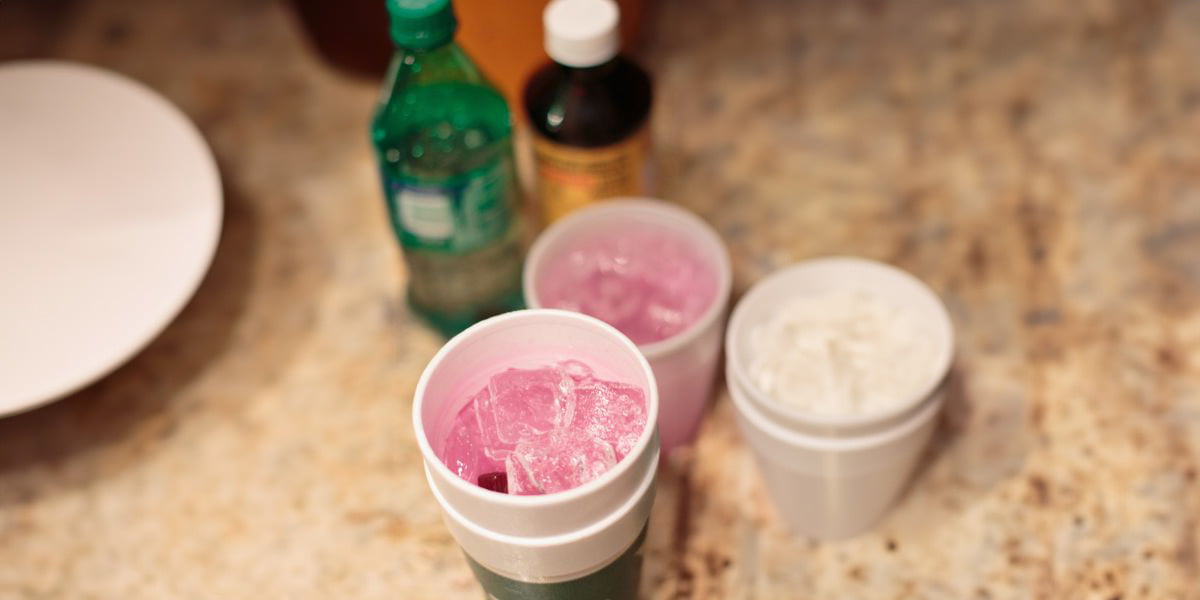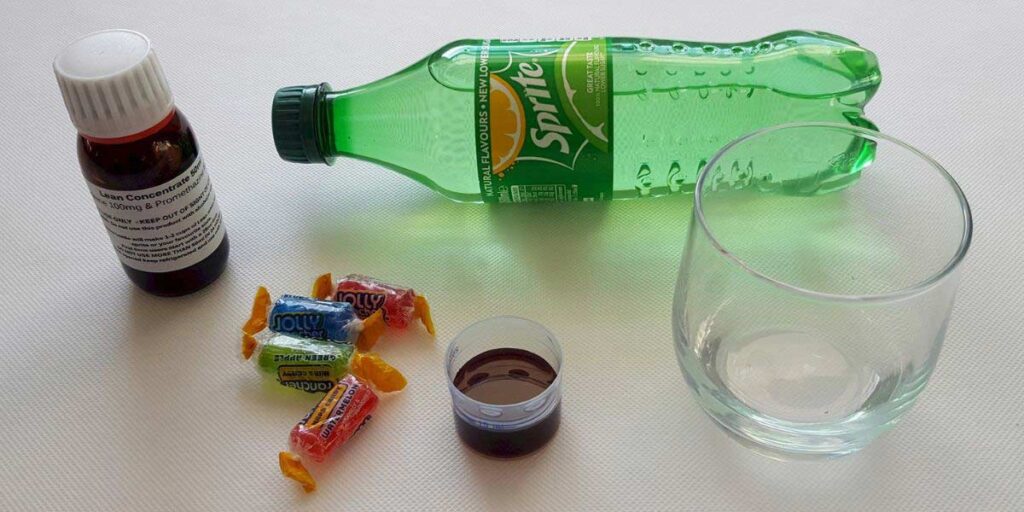What Is Lean?


Commonly referred to as the term lean or sizzurp, the concoction combining promethazine and codeine cough syrup with soda has gained popularity as a recreational substance within hip-hop and pop culture scenes.
Numerous music videos depict individuals consuming lean from red Solo cups or double-stacked styrofoam cups. However, this has led to addiction and fatalities because of its dangerous health effects.
While lean is often praised, it’s important to remember that it can be very dangerous. It can lead to addiction, opioid use disorders, and even fatal overdoses.
What Is Lean?
Lean, often termed sizzurp or purple drank, consists of a blend of prescription cough syrup with promethazine and codeine mixed with a carbonated beverage. To enhance the flavor and facilitate consumption, individuals may combine the codeine cough syrup with soda and sweets, such as Jolly Ranchers, creating a fruit-flavored concoction.
Purple drank is a recreational drug concoction that typically consists of a prescription-strength cough syrup containing codeine and promethazine mixed with a soft drink such as Sprite or Mountain Dew. The term “purple drank” comes from the distinctive purple color of many codeine-based cough syrups, which gives the drink its signature hue.
This concoction is often consumed for its sedative and euphoric effects, as codeine is an opioid that can produce feelings of relaxation and mild euphoria. However, the use of purple drank can be dangerous and even deadly, as it can lead to respiratory depression, overdose, and addiction.
Despite these risks, purple drank remains popular in certain subcultures, particularly in the southern United States. Nonetheless, the color of lean can vary as some opt to mix the cough syrup with sports drinks, juices, or alcohol, diverging from the traditional soda and candy combination.
Lean Ingredients
The active ingredients in lean are codeine and promethazine.
Codeine is classified as an opioid analgesic, a type of painkiller derived from the poppy plant, known for its high addiction potential. It is used for alleviating pain and suppressing coughs.
Promethazine helps with allergies by reducing symptoms like hives, sneezing, and runny nose.
Codeine and promethazine are chiefly recognized for their soothing properties. However, the National Institute on Drug Abuse (NIDA), suggests that when taken in high amounts, the mix of promethazine and codeine can trigger sensations of bliss and tranquility.
The Drug Enforcement Agency (DEA) reports that since codeine, the primary component in lean, is a regulated prescription painkiller, some individuals turn to over-the-counter cough syrups with Dextromethorphan (DXM), a cough suppressant available in more than 120 different cold medications, as an alternative.
Lean Drug Names
The term “lean” originates from the drowsy posture users often adopt, leaning over after consuming it. This concoction is also known as Texas tea, among other slang terms, referencing the mix of ingredients with prescription cough syrup.
Common slang terms for lean include:
- Dirty Sprite
- Purple stuff
- Oil
- Purple drank
- Syrup
- Sizzurp
- Texas tea
- Player potion

Copyright: The Drug Users Bible
Credit: Dominic Milton Trott
CC BY SA 2.0
Why Is Lean So Popular?
Lean’s popularity surged due to its frequent mentions and glamorization in pop culture, particularly in hip-hop. In Houston, Texas, it was not unusual for blues musicians to consume large amounts of cough syrup to experience the effects of codeine.
However, it only reached widespread fame in the 1990s, thanks to DJ Screw, a Houston rapper and producer who often mentioned it in his music and attributed his distinctive slow-paced production style to it. DJ Screw’s death in 2000 from an accidental overdose, with codeine, Valium, and PCP found in his system, highlighted its risks.
Musicians such as Lil’ Wayne, 3 6 Mafia, 2 Chains, Future, Juice Wrld, Mac Miller, and even Justin Bieber have made references to lean in their songs. These artists have played a significant role in popularizing these substances, which are often associated with the hip-hop and rap music scenes.
By mentioning this drug cocktail in their lyrics and interviews, these artists have brought attention to these substances and have contributed to their glamorization in popular culture. This has led to concerns about the impact of their influence on their young and impressionable fans, as the use of these substances can have serious health risks and consequences.
The availability of codeine-containing cough syrup or Dextromethorphan (DXM) and its addictive properties contribute to lean’s popularity. Moreover, some soft drink manufacturers have produced beverages with herbal components that replicate codeine’s sedative effects. Despite lacking lean’s active ingredients, these products are viewed by the United States Department of Justice (DOJ) as potential precursors to codeine use, substance misuse, and addiction.
Effects of Lean
When consumed, lean creates an intense sensation of joy and exhilaration, often leading to euphoria and heightened mood. This feeling of euphoria draws many users, providing a temporary escape from the stresses and pressures of everyday life.
In addition to its euphoric effects, the drink provides a distinctive mouthfeel that consumers favor. It coats the tongue and cheeks when consumed, creating a unique sensation that many users find enjoyable. This mouthfeel adds to the overall experience of using lean, making it a popular choice among those seeking a recreational high.
Overall, lean is a drug that offers users a combination of relaxation, euphoria, and a distinctive mouthfeel that sets it apart from other substances. Its ability to induce joy and exhilaration and its unique sensory experience makes it a sought-after drug among those seeking a temporary escape from reality.
The immediate effects of consuming lean include:
- Drowsiness
- Impaired coordination
- Feeling light-headed
- Experiencing dizziness
- Fainting
- Constipation
- Nausea and vomiting
- Blurred vision
- Respiratory issues
- Confusion or disorientation
- Facial flushing and skin redness
- Swallowing difficulties
- Stomach pains
Due to the lack of precise measurement of ingredients in lean preparation, predicting the specific effects and their duration is challenging. Combining sizzurp with alcohol and other substances heightens the danger of adverse reactions and the potential for a lethal opioid overdose.
Side Effects of Lean
Lean is highly addictive, and continuous consumption can result in enduring adverse effects. To experience its impact, one must consume large quantities, and similar to other opioid-based drugs, chronic abuse can significantly harm both the body and mind.
The side effects of abusing lean include:
- Memory impairment
- Urinary tract infections
- Constipation
- Weight increase
- Sleep disturbances
- Intense dreams
- Hallucinations
- Cardiac arrhythmia
- Dental decay
Long-Term Effects of Lean
Prolonged consumption of lean can result in tolerance, requiring larger doses to attain the desired high or to stave off opioid withdrawal symptoms. Users face numerous risks to their physical and mental health, such as addiction, opioid misuse, and opioid use disorder.
Moreover, lean’s inherent sedative properties can cause dangerous, potentially fatal interactions when combined with alcohol or other substances, particularly muscle relaxants.
The negative consequences of prolonged lean abuse includes:
- Memory deterioration
- Cognitive dysfunction
- Seizures or epilepsy
- Liver injury
- Kidney impairment
- Infertility
- Sexual dysfunction
- Menstrual cycle alterations
- Numbness in the face and extremities
- Loss of vision
- Coma
- Overdose
- Death

Lean Addiction
Addiction to lean can develop swiftly, with increased tolerance leading to more frequent and hazardous use. The belief that lean is safe because codeine is a prescribed medicine and is perceived as less potent than other opioids is misleading. Additionally, the mode of consumption, typically drinking rather than pill ingestion, snorting, or injection, leads some to underestimate the drink as a severe drug. These misconceptions are incorrect, and overlooking the potential for addiction is perilous.
Rapper Lil’ Wayne highlighted the difficulty of overcoming lean addiction, describing in an MTV interview that stopping its use feels like “death in your stomach.”
Lean Withdrawal
Lean impacts the central nervous system, leading to dependency. When users stop using, they experience withdrawal symptoms. The dread of withdrawal from codeine is a primary reason for continued lean abuse, requiring professional intervention and support to manage the addiction.
Lean withdrawal can be scary, sometimes posing life-threatening risks, with symptoms such as:
- Shaking
- Twitching
- Muscle pain
- Stomach cramps
- Diarrhea
- Vomiting
- Experiencing hot and cold flashes
- Sweating
- Sleep disturbances
- Respiratory difficulties
- Elevated heart rate
If you are addicted to lean, abruptly discontinuing its use will lead to withdrawal symptoms. It is advisable to seek medical guidance if you intend to stop using it.
Help for Lean Addiction
Addiction to lean is just as risky and difficult to overcome as addiction to any opioid.
At White Oak Recovery Center, our caring, experienced, and licensed staff can manage your severe withdrawal symptoms through medically supervised detox. We help you make a personalized treatment plan using methods like dual diagnosis, therapy, and support groups for effective results.
At WORC, we want to help you improve your mental and physical health. We will give you the tools to start a new and meaningful life with lasting recovery.
Our administrative team will assess your insurance coverage for treatment costs and address any additional inquiries or concerns.
Embarking on the path to recovery can seem daunting, but you are not alone. Contact us to start your journey towards healing, confident that we are here to support you at every step.

Am I covered for addiction treatment?
Your insurance may cover treatment. Call now for an entirely free and confidential assessment. Recovery starts with a phone call.

- “Resurgence in Abuse of ‘Purple Drank.’” U.S. Department of Justice National Drug Intelligence Center, Feb. 2011.
- “Codeine Information.” U.S. Food and Drug Administration, Oct. 2023.
- Miuli, A., et al., “’Purple Drank’ (Codeine and Promethazine Cough Syrup): A Systematic Review of a Social Phenomenon with Medical Implications.” J Psychoactive Drugs, Aug. 2020.
- “Codeine.” MedlinePlus: National Library of Medicine (US), Apr. 2024.
- Ware, Orrin D., et al., “Codeine and Promethazine: Exploratory Study on ‘Lean’ or ‘Sizzurp’ Using National Survey Data and an Online Forum.” Plos One, Mar. 2024.
Medical Disclaimer:







